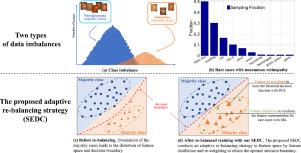Medical Image Analysis ( IF 10.7 ) Pub Date : 2021-10-29 , DOI: 10.1016/j.media.2021.102295 Rongchang Zhao 1 , Xuanlin Chen 1 , Zailiang Chen 1 , Shuo Li 2

|
Glaucoma diagnosis often suffers from two types of data imbalances: 1) class imbalance, i.e., the non-glaucoma majority cases occupy most of the data; 2) rare cases, i.e., few cases present the uncommon retinopathy e.g., bayoneting or physiologic cupping. This dual-imbalances make glaucoma diagnosis model easy to be dominated by the majority cases but cannot correctly classify the minority and/or rare ones. In this paper, we propose an adaptive re-balancing strategy in the feature space, Self-Ensemble Dual-Curriculum learning (SEDC), to improve the glaucoma diagnosis on imbalanced data by augmenting feature distribution with feature distilling and feature re-weighting. Firstly, the self-ensembling (SEL) is developed to reinforce the discriminative ability of feature representations for the minority class and rare cases by distilling the features learned from the abundant majority cases. Secondly, the dual-curriculum (DCL) is designed to adaptively re-weight the imbalanced data in the feature space to learn a balanced decision function for accurate glaucoma diagnosis. Benefiting from feature distilling and re-weighting, the proposed SEDC fairly represents fundus images, regardless of the majority or rare cases, by augmenting the feature distribution to obtains the optimal decision boundary for accurate glaucoma diagnosis on the imbalanced dataset. Experimental results on three challenging glaucoma datasets show that our SEDC successfully delivers accurate glaucoma diagnosis by the adaptive re-balancing strategy, with the average mean value of Accuracy 0.9712, Sensitivity 0.9520, Specificity 0.9816, AUC 0.9928, F2-score 0.9547. Ablation and comparison studies demonstrate that our method outperforms state-of-the-art methods and traditional re-balancing strategies. The experiment also shows that the adaptive re-balancing strategy proposed in our method provides a more effective training approach with optimal convergence performance. It endows our SEDC a great advantage to handle the disease diagnosis on imbalanced data distribution.
中文翻译:

基于自集成双课程学习的不平衡数据诊断青光眼
青光眼诊断往往存在两种数据不平衡:1)类别不平衡,即 非青光眼多数病例占据了大部分数据;2) 罕见病例,即 很少有病例出现不常见的视网膜病变,例如 卡口或生理拔罐. 这种双重不平衡使得青光眼诊断模型容易被大多数病例支配,但不能正确分类少数和/或罕见病例。在本文中,我们提出了一种在特征空间中的自适应重新平衡策略,即自集成双课程学习 (SEDC),通过通过特征提取和特征重新加权来增强特征分布来改进对不平衡数据的青光眼诊断。首先,自集成(SEL)被开发出来,通过提取从丰富的多数案例中学习到的特征来增强特征表示对少数类和稀有案例的区分能力。其次,双课程(DCL)旨在自适应地重新加权特征空间中的不平衡数据,以学习平衡的决策函数以进行准确的青光眼诊断。受益于特征提取和重新加权,所提出的 SEDC 公平地表示眼底图像,无论大多数或少数情况,通过增加特征分布以获得最佳决策边界,以便在不平衡的数据集上进行准确的青光眼诊断。三个具有挑战性的青光眼数据集的实验结果表明,我们的 SEDC 通过自适应再平衡策略成功地提供了准确的青光眼诊断,其平均值为 Accuracy 0.9712、Sensitivity 0.9520、Specificity 0.9816、AUC 0.9928、F2-score 0.9547。消融和比较研究表明,我们的方法优于最先进的方法和传统的再平衡策略。实验还表明,我们方法中提出的自适应重新平衡策略提供了一种更有效的训练方法,具有最佳的收敛性能。它赋予了我们的 SEDC 在处理不平衡数据分布上的疾病诊断方面的巨大优势。









































 京公网安备 11010802027423号
京公网安备 11010802027423号